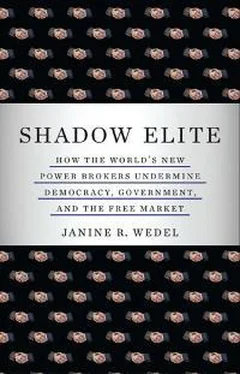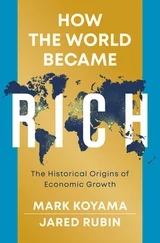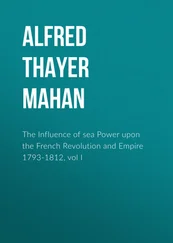The trends we see in the think tank world are consistent with more general ones: the movement away from neutrality, the emphasis on sound bites, and the shift toward partisanship and politicization. Think tanks, then, are but one illustration of the way in which the distinctions among government, business, and other institutions have become less clear. Built-in institutional ambiguity creates fertile ground for those who would pursue coincidences of interest. And, of course, this elevates these players beyond the reach of traditional monitoring.
The End of Loyalty to Institutions?
The HHS banner congratulating employees for handing agency work to outsiders is emblematic. Waning loyalty of institutions to people and of people to institutions (congruent with the flex-ability inherent in ambiguous authority and Swiss-cheese bureaucracy filling in for shadow government) goes hand in hand with the proliferation of people’s roles. Both parties have greater expectation that the employee will perform multiple jobs and projects simultaneously, and less expectation of long-lasting affiliation and loyalty. 68
An employee working for a small international development consulting firm that receives contracts from the U.S. Agency for International Development (USAID), the government’s foreign aid arm, describes what he calls a “lack of demonstrated loyalty to the company by independent consultants.” He reports:
Because ours is a small firm, the vast majority of the people that work on the company’s projects in the field are independent consultants. The consequence of this relationship is that once the consultant’s assignment is over, there is no guarantee of additional work—or money. Therefore, when implementing assignments in the field, consultants tend simultaneously to be looking for their next assignment, which often involves brownnosing with competitors of the company that are working in the same country. Also, because they have no real ties to our company, these consultants usually do not go out of their way to help in the long run, by, for example, giving us notice of an upcoming project that they have heard about through the local U.S. expatriate gossip mill. This negatively affects the company because having advance notice of a project gives us time to pre-recruit. If we do not have the same advance notice as our competitors, by the time the Request for Proposals is formally released by USAID, all the best people have already been recruited by the other firms that did have advance notice, which makes winning a project significantly more difficult.
An example of this type of situation involves Mr. G., who was hired by our company to lead a rule of law project in Jordan. He has been there for about 10 months now. Last month, we saw a publicly posted Request for Proposals from USAID for work in that country that was right up our and Mr. G’s alley. We had been unaware that USAID planned to fund such a project. When one of our employees asked Mr. G. about it, he said: “Yes, I knew it was coming but didn’t think you’d be interested.” This was clearly a lie because it was exactly the type of project on which we always bid. Over the course of the next week, we found out that Mr. G. was in negotiations with another firm about working on the project. That firm had approached Mr. G., saying that if he went with them and if they won the contract, they would pay him much more than we were paying. This made it more lucrative for Mr. G. to withhold information about the upcoming project from us and to help the other firm win it.
As a short-term consultant, it behooves Mr. G. to adopt multidimensional professional roles, rather than the one-dimensional roles of an earlier era. Through Mr. G. we see but one example of how loyalty to institutions no longer is as wise as it once was. In fact, the GAO has found that “compared to direct-hire staff, personal services contractors generally do not have the same level of agency commitment . . . [and] are not subject to the same degree of accountability.” Clearly this observation applies to such contractors no matter the government agency. 69
Because people play more professional roles than in the past, players are better able to actively structure their roles to suit themselves amid declining loyalty to institutions. Today, top government posts seem like stepping stones on the career path to the private sector gravy train, and the “big boys” who have held these posts and now perform for big ticket contractors carry great cachet and legitimacy in policy and influence circles. Following Steven Kelman’s “evolving door,” these influencers move in and out of institutions along their career paths, never permanently fixed to any. Like many other high-powered players, they are apt to ensconce themselves, at least temporarily, in think tanks and consulting firms, and more likely to work for more than one institution at a time or move among them in more rapid succession or with more alacrity than in the past.
Officials go to companies and then back to government, but the landing spots that supply the big bucks, and with them the influence and stature, are often those held by former government officials now in an industry perch. Although there are rules to address the revolving door syndrome, companies with significant government contracts are often headed by former senior officials of intelligence- and defense-related government agencies. 70For instance, William Studeman, former director of the National Security Agency (NSA), where outsourcing has grown rapidly, is now a vice president of Northrop Grumman, the defense giant. Three of Booz Allen’s current and former vice presidents previously served as intelligence agency directors, including James Woolsey, a Neocon core member who headed the CIA during the Clinton administration. And a number of former defense and intelligence officials, including defense secretaries Melvin R. Laird and William J. Perry, CIA directors John M. Deutch and Robert M. Gates, and NSA director Bobby R. Inman, have either worked for or served on Booz Allen’s board. 71
Means of accountability have not evolved accordingly. While conflict-of-interest laws and regulations are well established, rules and practices designed to address coincidences of interest are not. And, when government contractors hire former directors of intelligence- and defense-related government agencies, they are banking on coincidences of interest between their hires and their hires’ former (government) employers. In these coincidences, “The Intelligence Community and the contractors are so tightly intertwined at the leadership level that their interests, practically speaking, are identical,” as one intelligence expert put it. 72
Coincidences of interest, together with sagging institutional loyalty, employees who come and go, a fading ethos of public service, and unsecured databases, among other phenomena, introduce fundamental vulnerabilities into an institution, whether governmental or business. And when these vulnerabilities exist in the realm of national security and foreign policy, one can only wonder about the nation’s sovereignty. 73
Enhanced Executive Power
While today’s influencers busily pursue coincidences of interest and move quickly to plug holes in Swiss-cheese bureaucracy, they also take advantage of executive power. Its intensification and concentration in the United States, again, has largely occurred under the radar. Enhancing executive power is not new, but it is another feature of the governing landscape that heightens the influence prospects of strategic players, who not only work across the system, but also from the top down. They avail themselves of opportunities to take over public policy agendas in pursuit of their own interests and operate beyond the reach of the checks and balances that Americans earlier enjoyed.
Читать дальше












